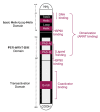Plant Occurring Flavonoids as Modulators of the Aryl Hydrocarbon Receptor
- PMID: 33923487
- PMCID: PMC8073824
- DOI: 10.3390/molecules26082315
Plant Occurring Flavonoids as Modulators of the Aryl Hydrocarbon Receptor
Abstract
The aryl hydrocarbon receptor (AhR) is a transcription factor deeply implicated in health and diseases. Historically identified as a sensor of xenobiotics and mainly toxic substances, AhR has recently become an emerging pharmacological target in cancer, immunology, inflammatory conditions, and aging. Multiple AhR ligands are recognized, with plant occurring flavonoids being the largest group of natural ligands of AhR in the human diet. The biological implications of the modulatory effects of flavonoids on AhR could be highlighted from a toxicological and environmental concern and for the possible pharmacological applicability. Overall, the possible AhR-mediated harmful and/or beneficial effects of flavonoids need to be further investigated, since in many cases they are contradictory. Similar to other AhR modulators, flavonoids commonly exhibit tissue, organ, and species-specific activities on AhR. Such cellular-context dependency could be probably beneficial in their pharmacotherapeutic use. Flavones, flavonols, flavanones, and isoflavones are the main subclasses of flavonoids reported as AhR modulators. Some of the structural features of these groups of flavonoids that could be influencing their AhR effects are herein summarized. However, limited generalizations, as well as few outright structure-activity relationships can be suggested on the AhR agonism and/or antagonism caused by flavonoids.
Keywords: Ah receptor; bioactive; dioxin receptor; flavonoids; functional food; phytochemicals; phytocompounds; polyphenols; transcription factor; xenobiotics.
Conflict of interest statement
The authors declare no conflict of interest.
Figures




References
Publication types
MeSH terms
Substances
Grants and funding
LinkOut - more resources
Full Text Sources
Other Literature Sources

